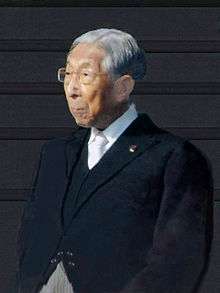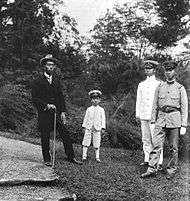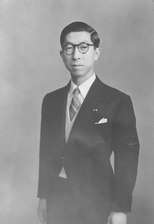Takahito, Prince Mikasa
| Takahito | |||||
|---|---|---|---|---|---|
| Prince Mikasa | |||||
 At the new year congratulatory imperial palace visit, 2 January 2012 | |||||
| Born |
2 December 1915 Tokyo Imperial Palace, Tokyo City, Empire of Japan (now Chiyoda, Tokyo) | ||||
| Died |
27 October 2016 (aged 100) St. Luke's International Hospital, Tokyo, Japan | ||||
| Burial |
4 November 2016 Toshimagaoka Imperial Cemetery, Tokyo | ||||
| Spouse | |||||
| Issue | |||||
| |||||
| House | Imperial House of Japan | ||||
| Father | Emperor Taishō | ||||
| Mother | Empress Teimei | ||||
| Military career | |||||
| Allegiance |
| ||||
| Service/ |
| ||||
| Years of service | 1932–1945 | ||||
| Rank | Major | ||||
| Unit |
China Expeditionary Army Imperial General Headquarters | ||||
| Battles/wars |
Second Sino-Japanese War Second World War | ||||
Takahito, Prince Mikasa (三笠宮崇仁親王 Mikasa-no-miya Takahito Shinnō, 2 December 1915 – 27 October 2016) was a Japanese royal, member of the Imperial House of Japan. He was the fourth and youngest son of Emperor Taishō and Empress Teimei and was their last surviving child, the last surviving paternal uncle of Emperor Akihito. His eldest brother was Emperor Shōwa (Hirohito). After serving as a junior cavalry officer in the Japanese Imperial Army during World War II, the prince embarked upon a post-war career as a scholar and part-time lecturer in Middle Eastern studies and Semitic languages.
With the death of his sister-in-law, Kikuko, Princess Takamatsu, on 17 December 2004, he became the oldest living member of the Imperial House of Japan. As a centenarian, Prince Takahito was the oldest living royal, the oldest living prince in line of succession,[1] and also the last one in it. He died at age 100 on 27 October 2016 of cardiac arrest after being hospitalized for pneumonia.[2][3]
Early life

Prince Takahito was born at the Tokyo Imperial Palace, in the third year of his father's reign and a full fifteen years after the birth of the future Emperor Shōwa. His childhood appellation was Sumi-no-miya. Prince Takahito attended the boys' elementary and secondary departments of the Gakushūin (Peers' School) from 1922 to 1932. By the time he began his secondary schooling, his eldest brother had already ascended the Chrysanthemum Throne and his next two brothers, Prince Chichibu and Prince Takamatsu, had already embarked upon careers in the Japanese Imperial Army and the Japanese Imperial Navy, respectively. He enrolled in the Imperial Japanese Army Academy in 1932 and was commissioned as a sub-lieutenant and assigned to the Fifth Cavalry Regiment in June 1936. He subsequently graduated from the Army Staff College.
Upon attaining the age of majority in December 1935, Emperor Shōwa granted him the title Mikasa-no-miya (Prince Mikasa) and the authorization to form a new branch of the Imperial Family.
Military service

Prince Mikasa was promoted to lieutenant in 1937 and to captain in 1939, serving in China under the name of "Wakasugi". During his army career, he was harshly critical of the Japanese military's conduct in China.[4] In a 1994 interview, he criticised the Imperial Army's invasion of and atrocities in China, and recalled having been "strongly shocked" when an officer informed him that the best way to train new recruits was to use living Chinese POWs for bayonet practice.[4] According to Daniel Barenblatt, Prince Mikasa and his cousin Prince Tsuneyoshi Takeda received a special screening by Shirō Ishii of a film showing airplanes loading germ bombs for bubonic plague dessemination over the Chinese city of Ningbo in 1940.[5] He also was given a film of Japanese atrocities, possibly linked to the footage used in The Battle of China, and was so moved that he made his brother Emperor Hirohito watch the film.[6]
In 1994, a newspaper revealed that after Prince Mikasa's return to Tokyo, he had written a stinging indictment of the conduct of the Imperial Japanese Army in China, where the Prince had witnessed Japanese atrocities against Chinese civilians. The Imperial Army General Staff suppressed the document, but one copy survived and surfaced in 1994.[7] After the war, it was reported that while an officer, Prince Mikasa had taken a strict stance against lax discipline and the cruel actions of Japanese soldiers serving in China.[8]
Promoted to major in 1941, Prince Mikasa served as a staff officer in the Headquarters of the China Expeditionary Army at Nanjing, China from January 1943 to January 1944. His role was intended to bolster the legitimacy of the Wang Jingwei regime and to coordinate with Japanese Army staff towards a peace initiative, but his efforts were totally undermined by the Operation Ichi-Go campaign launched by the Imperial General Headquarters.[9]
Prince Mikasa served as a staff officer in the Army Section of the Imperial General Headquarters in Tokyo until Japan's surrender in August 1945. After the end of the war, the Prince spoke before the Privy Council, urging that Hirohito abdicate to take responsibility for the war.[10]
Marriage
On 22 October 1941, Prince Mikasa married Yuriko Takagi (born 4 June 1923), the second daughter of Viscount (kazoku, pre-war Japan's upper classes) Masanari Takagi. Prince and Princess Mikasa had five children. In addition to their five children, they had nine grandchildren and four great-grandchildren as of 2015.[1] The couple's two daughters left the Imperial Family upon marriage. All of their sons predeceased them.
Children
- Yasuko Konoe (近衛やす子 Konoe Yasuko) (formerly Princess Yasuko of Mikasa (甯子内親王 Yasuko Naishinno, born 26 April 1944); married on 16 December 1966 to Tadateru Konoe, younger brother of former Prime Minister Morihiro Hosokawa and adopted grandson (and heir) of former Prime Minister Fumimaro Konoe, currently President of the Japanese Red Cross Society; has a son, Tadahiro, who has three children.
- Prince Tomohito of Mikasa (寬仁親王 Tomohito Shinnō, 5 January 1946 – 6 June 2012); heir apparent; married on 7 November 1980 to Nobuko Asō (born 9 April 1955), third daughter of Takakichi Asō, chairman of Aso Cement Co., and his wife, Kazuko, the daughter of former Prime Minister Shigeru Yoshida; had two daughters.
- Yoshihito, Prince Katsura (桂宮宜仁親王 Katsura-no-miya Yoshihito Shinnō, 11 February 1948 – 8 June 2014); created Katsura-no-miya on 1 January 1988.
- Masako Sen (千容子 Sen Masako) (formerly Princess Masako of Mikasa (容子内親王 Masako Naishinnō, born 23 October 1951); married on 14 October 1983 to Sōshitsu Sen (born 7 June 1956), the elder son of Sōshitsu Sen XV, and currently the sixteenth hereditary grand master (iemoto) of the Urasenke Japanese tea ceremony School; and has two sons, Akifumi and Takafumi, and a daughter, Makiko.
- Norihito, Prince Takamado (高円宮憲仁親王 Takamado-no-miya Norihito Shinnō, 29 December 1954 – 21 November 2002); created Takamado-no-miya on 1 December 1984; married on 6 December 1984 to Hisako Tottori (born 10 July 1953), eldest daughter of Shigejiro Tottori, former President, Mitsui & Co. in France; and had three daughters.
Post-war career

After the defeat of Japan in World War II, many members of the imperial family, such as Princes Chichibu, Takamatsu and Higashikuni, pressed Emperor Hirohito to abdicate so that one of the Princes could serve as regent until Crown Prince Akihito came of age.[11] On 27 February 1946, Prince Mikasa even stood up in the privy council and indirectly urged the emperor to step down and accept responsibility for Japan's defeat. U.S. General of the Army Douglas MacArthur insisted that Emperor Hirohito retain the throne. According to Minister of Welfare Ashida's diary, "Everyone seemed to ponder Mikasa's words. Never have I seen His Majesty's face so pale."[12]
After the war, Prince Mikasa enrolled in the Literature Faculty of the University of Tokyo and pursued advanced studies in archaeology, Middle Eastern studies, and Semitic languages. From 1954 until his death in 2016, he directed the Japanese Society for Middle East Studies. He was honorary president of the Japan Society of Orientology. The Prince held visiting and guest faculty appointments in Middle Eastern studies and archaeology at various universities in Japan and abroad, including: Tokyo National University of Fine Arts and Music, Aoyama Gakuin, Tokyo Woman's Christian University, the University of London, Hokkaido University and the University of Shizuoka. He made numerous radio and television appearances, speaking on cultural subjects, and was known as "the Imperial scholar".[13]
Final years and death
Towards the end of his life, due to his advanced age, Prince Mikasa rarely made public appearances, and regularly used a wheelchair. He and Princess Mikasa lived together at a residence in the grounds of the Akasaka Estate in Motoakasaka, Minato, Tokyo. He underwent heart surgery in 2012, and made a full recovery. His routine included exercising for about 30 minutes each day with his wife at their Tokyo residence, and he often went outdoors for a roll in his wheelchair. About once a week, he would leave his home for a haircut, or to attend various events for other family members. In October 2014, he attended the Tokyo wedding of his granddaughter Princess Noriko, the second daughter of his youngest son Prince Takamado. Palace staff noted that he appeared vigorous until his last days, and that he would always be seen helping his wife to get about.[13] He continued to read newspapers, and enjoyed watching sumo and music programs on television.[14]
On 2 December 2015, Prince Mikasa became the first member of the imperial family to become a centenarian.[lower-alpha 1] On his 100th birthday, he said, "Nothing will change just because I turn 100 years old. I'd like to spend my days pleasantly and peacefully while praying for the happiness of people around the world and thanking my wife, Yuriko, who has been supporting me for more than 70 years."[14] At his residence in April 2016, he met the Japanese ambassador to Turkey and took a stroll at the Akasaka Detached Palace.[8]
On 16 May 2016, Prince Mikasa was admitted to the intensive-care unit of St. Luke's International Hospital in Tokyo's Chuo Ward, having contracted acute pneumonia.[13] He remained in hospital for the remaining months of his life. His heart weakened in June, and fluid accumulated in his lungs.[8] Princess Yuriko frequently visited him along with other Imperial family members, including the Emperor and Empress in June. During his last days, Prince Mikasa remained responsive to visitors.[13] On 22 October, Prince Mikasa and his wife celebrated their 75th wedding anniversary in his hospital room.[8] His condition eventually stabilised to the point where he began to receive rehabilitation in his bed, which included stretching his arms and legs. At 7:40 a.m. on 27 October, however, his heart gradually slowed, stopping at 8 a.m. Prince Mikasa was pronounced dead at 8:34 a.m., with his wife at his side. At his death, he had outlived all of his siblings and all three of his sons.[8][13] He was also the last surviving grandson of Emperor Meiji.
Prince Mikasa's funeral was held on 4 November 2016 at Toshimagaoka Imperial Cemetery.[16] About 580 people including members of the Imperial Family, Prime Minister Shinzō Abe, U.S. Ambassador Caroline Kennedy, Emperor Akihito's daughter Sayako Kuroda and her husband Yoshiki Kuroda, and Prince Mikasa's own granddaughter Noriko Senge and her husband Kunimaro Senge, attended the funeral.[16] Princess Mikasa hosted the ceremony as the chief mourner.[16]
Titles, styles and honours
Titles
| Styles of Prince Mikasa | |
|---|---|
 | |
| Reference style | His Imperial Highness |
| Spoken style | Your Imperial Highness |
| Alternative style | Sir |
- 2 December 1915 – 2 December 1935: His Imperial Highness The Prince Sumi
- 2 December 1935 – 27 October 2016: His Imperial Highness The Prince Mikasa
Honours
National honours
- Knight Grand Cordon of the Order of the Chrysanthemum[17]
Foreign honours



.svg.png)
.svg.png)





Honorary positions
- Honorary President of the Middle Eastern Culture Center in Japan.
- Honorary President of the Japan – Turkey Society.
- Honorary Vice-President of the Japanese Red Cross Society.
Issue
| Name | Birth | Death | Marriage | Issue | |
|---|---|---|---|---|---|
| Princess Yasuko of Mikasa | 26 April 1944 | 16 December 1966 | Tadateru Konoe | Tadahiro Konoe | |
| Prince Tomohito of Mikasa | 5 January 1946 | 6 June 2012 | 7 November 1980 | Nobuko Asō | Princess Akiko of Mikasa Princess Yōko of Mikasa |
| Yoshihito, Prince Katsura | 11 February 1948 | 8 June 2014 | |||
| Princess Masako of Mikasa | 23 October 1951 | 14 October 1983 | Soshitsu Sen | Akifumi Sen Takafumi Sen Makiko Sen | |
| Norihito, Prince Takamado | 29 December 1954 | 21 November 2002 | 6 December 1984 | Hisako Tottori | Princess Tsuguko of Takamado Princess Noriko of Takamado Princess Ayako of Takamado |
Ancestry
| Ancestors of Takahito, Prince Mikasa | ||||||||||||||||||||||||||||||||||||||||||||||||||||||||||||||||||||||||||||||||||||||||||||||||||||||||||||||||||||||||||||||||||||||||||||||||||||||||||||||||||||||||||||||||||||||||||||||||||||||||||||||||||||||||||||||||||||||||||||||||||||||||||||||||||||||||||||||||||||||||||||||||||||||||||||||||||||||||||||||||||||||||||||||||||||||||||||||||||||||||||||||||||||||||||||||||||||||||||||||||||||||||||||||||||||||||||||||||||||||||||||||||||||||||||||||||||||||||||||||||||||||||||||||||||||||||||||||||||||||||||||||||||||||||||||||||||||||||||||||||||||||||||||||||
|---|---|---|---|---|---|---|---|---|---|---|---|---|---|---|---|---|---|---|---|---|---|---|---|---|---|---|---|---|---|---|---|---|---|---|---|---|---|---|---|---|---|---|---|---|---|---|---|---|---|---|---|---|---|---|---|---|---|---|---|---|---|---|---|---|---|---|---|---|---|---|---|---|---|---|---|---|---|---|---|---|---|---|---|---|---|---|---|---|---|---|---|---|---|---|---|---|---|---|---|---|---|---|---|---|---|---|---|---|---|---|---|---|---|---|---|---|---|---|---|---|---|---|---|---|---|---|---|---|---|---|---|---|---|---|---|---|---|---|---|---|---|---|---|---|---|---|---|---|---|---|---|---|---|---|---|---|---|---|---|---|---|---|---|---|---|---|---|---|---|---|---|---|---|---|---|---|---|---|---|---|---|---|---|---|---|---|---|---|---|---|---|---|---|---|---|---|---|---|---|---|---|---|---|---|---|---|---|---|---|---|---|---|---|---|---|---|---|---|---|---|---|---|---|---|---|---|---|---|---|---|---|---|---|---|---|---|---|---|---|---|---|---|---|---|---|---|---|---|---|---|---|---|---|---|---|---|---|---|---|---|---|---|---|---|---|---|---|---|---|---|---|---|---|---|---|---|---|---|---|---|---|---|---|---|---|---|---|---|---|---|---|---|---|---|---|---|---|---|---|---|---|---|---|---|---|---|---|---|---|---|---|---|---|---|---|---|---|---|---|---|---|---|---|---|---|---|---|---|---|---|---|---|---|---|---|---|---|---|---|---|---|---|---|---|---|---|---|---|---|---|---|---|---|---|---|---|---|---|---|---|---|---|---|---|---|---|---|---|---|---|---|---|---|---|---|---|---|---|---|---|---|---|---|---|---|---|---|---|---|---|---|---|---|---|---|---|---|---|---|---|---|---|---|---|---|---|---|---|---|---|---|---|---|---|---|---|---|---|---|---|---|---|---|---|---|---|---|---|---|---|---|---|---|---|---|---|---|---|---|---|---|---|---|---|---|---|---|---|---|---|---|---|---|---|---|---|---|---|---|---|---|---|---|---|---|---|---|---|---|---|---|---|---|---|---|---|---|---|---|---|---|---|---|---|---|---|---|---|---|---|---|---|---|---|---|---|---|---|---|---|---|---|---|---|---|---|---|---|---|---|---|---|---|---|---|---|---|---|---|---|---|---|---|---|---|---|---|---|---|---|---|---|---|---|---|---|---|---|---|---|---|---|---|---|---|---|---|---|---|---|---|---|---|---|---|---|---|---|---|---|---|---|---|---|---|---|---|---|---|---|---|---|---|---|---|---|
| ||||||||||||||||||||||||||||||||||||||||||||||||||||||||||||||||||||||||||||||||||||||||||||||||||||||||||||||||||||||||||||||||||||||||||||||||||||||||||||||||||||||||||||||||||||||||||||||||||||||||||||||||||||||||||||||||||||||||||||||||||||||||||||||||||||||||||||||||||||||||||||||||||||||||||||||||||||||||||||||||||||||||||||||||||||||||||||||||||||||||||||||||||||||||||||||||||||||||||||||||||||||||||||||||||||||||||||||||||||||||||||||||||||||||||||||||||||||||||||||||||||||||||||||||||||||||||||||||||||||||||||||||||||||||||||||||||||||||||||||||||||||||||||||||
Notes
- ↑ A cousin, Higashifushimi Kunihide, was 103 at his death in 2014, but had left the imperial family in 1931 to establish a branch of the Higashifushimi-no-miya.[15] Another cousin, Prince Naruhiko Higashikuni, lived to 102 but lost his imperial titles after World War II.
References
Citations
- 1 2 "Prince Mikasa, Emperor Akihito's uncle, turns 100". The Japan Times. 2 December 2015. Retrieved 2 December 2015.
- ↑ "Prince Mikasa, a China war veteran who spanned three reigns, dies at 100". The Japan Times. 27 October 2016. Retrieved 27 October 2016.
- ↑ Kaneko, Kaori (27 October 2016). "Japan's Prince Mikasa, oldest imperial family member, dies at 100". Reuters. Retrieved 27 October 2016.
- 1 2 Yoshida, Reiji (27 October 2016). "Prince Mikasa, a China war veteran who spanned three reigns, dies at 100". The Japan Times. Retrieved 27 October 2016.
- ↑ Daniel Barenblatt, A Plague upon Humanity, 2004, p.32.
- ↑ 「闇に葬られた皇室の軍部批判」、『This is 読売』、一九九四年八月号57ページ
- ↑ McCarthy, Terry (6 July 1994). "Tokyo 'in 1931 Poison Plot'". The Independent. Retrieved 27 October 2016.
- 1 2 3 4 5 "UPDATE: Prince Mikasa, uncle of Akihito, dies at 100 years old". Asahi Shimbun. 27 October 2016. Retrieved 27 October 2016.
- ↑ Bix, Hirohito and the Making of Modern Japan, 2000, Page 474
- ↑ Bix, Hirohito and the Making of Modern Japan, 2000, Page 572
- ↑ Bix, Hirohito and the Making of Modern Japan, 2000, pp. 571–573.
- ↑ Ashida Hitoshi Nikki, Dai Ikkan, Iwanami Shoten, 1986, p. 82.
- 1 2 3 4 5 "Prince Mikasa spent his last years peacefully at Tokyo residence". The Japan Times. 27 October 2016. Retrieved 27 October 2016.
- 1 2 "Prince Mikasa, Emperor Akihito's uncle, turns 100". The Japan Times. 2 December 2015. Retrieved 2 December 2015.
- ↑ 東伏見慈洽さん死去 天皇陛下の叔父 [Emperor's uncle, Higashifumi Kunihide dies]. Asahi Shimbun Digital (in Japanese). The Asahi Shimbun Company. 1 January 2014. Retrieved 2 December 2015.
- 1 2 3 "Prince Mikasa laid to rest in Imperial rite". The Japan Times. 4 November 2016. Retrieved 5 January 2017.
- 1 2 3 4 5 6 7 8 9 newscom.com, Orders shown at the funeral of Prince Takahito
- ↑ "Persondetaljer - Hans Kejserlige Højhed Mikasa" [Person Details - His Imperial Highness Mikasa] (in Danish). Archived from the original on 7 December 2013. Retrieved 27 October 2016.
- ↑ http://1.bp.blogspot.com/-nrPbpZjq8UY/T6qzYQbvUcI/AAAAAAAABiE/VPb0vNTuY_Q/s1600/857034au.jpg
- ↑ "Grand State Banquet - Iran - Host to the World". Badraie. Archived from the original on 10 March 2016. Retrieved 27 October 2016.
- ↑ "S.A.I. Takahito di Mikasa Principe del Giappone" [S.A.I. Takahito Mikasa, Prince of Japan]. Presidenza della Repubblica (Presidency of the Republic) (in Italian). Retrieved 27 October 2016.
- ↑ "Genealogy". Reichsarchiv. Retrieved 29 October 2017. (in Japanese)
Sources
- Bix, Herbert P. (2000). Hirohito and the Making of Modern Japan. New York: Harper and Collins. ISBN 978-0-06-019314-0.
External links
| Wikimedia Commons has media related to Prince Mikasa. |
- Their Imperial Highnesses Prince and Princess Mikasa and their family at the Imperial Household Agency website
